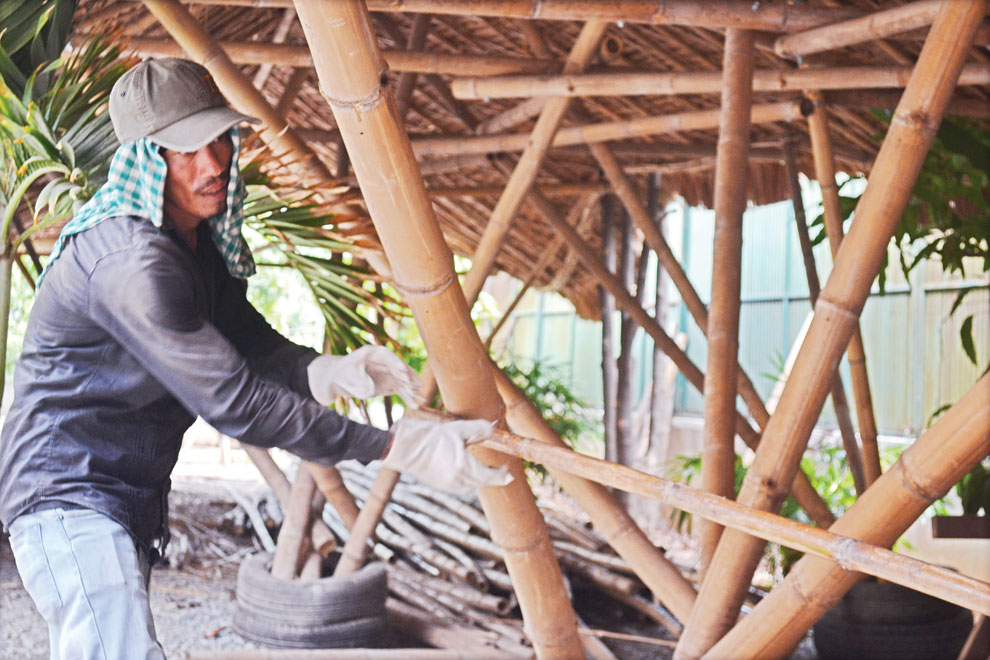
A mix of Chinese bamboo, village bamboo, and ping-pong bamboo lie on the ground at the Bamboo Center in Takhmao.
Different countries have different natural resources that can be honed into everyday use. Like Sierra Leone, Uganda, and other African countries have their rammed earth, or better known as clay, Cambodia has its bamboo.
The recent Camboo Festival held from March 29 to April 1 at Freedom Park was dedicated to showcasing bamboo as a sustainable and renewable resource that can be molded into anything from a bridge, to furniture, and even to full-blown bamboo houses.
An initiative by Building Trust International (BTI), a UK-based non-governmental organisation promoting sustainable development, the festival featured structures constructed entirely of bamboo by students from Phnom Penh universities whose designed were inspired by elements of nature. It also highlighted the various locations where developments made of bamboo had been erected – one of them the Bamboo Center in Takhmao town.

The Bamboo Center is two storeys, and acts as a workshop and training facility for local and international designers and architects. Vandy Muong
Said David Cole, founder and director of BTI, who came to Cambodia in 2013 to provide design support for affordable housing in the wake of a major flood: “The great thing about using bamboo and natural products is revitalising traditional skills and working with skilled workers both valuing and passing on these skills to the next generation to be used in a modern way.”
In 2015, French group Architects Without Territories (ASTER), descended upon Takhmao town to build a structure made absolutely out of bamboo with the main goal of it being a training centre on how to make proper use of bamboo. It also acted as a material testing lab.
A year later, the facility was taken on by BTI as a bamboo treatment centre and educational facility in the aims of training local and international architects and designers on constructing with bamboo.
For Pablo Marcet, project manager at BTI, this was the case. Having come onboard the bamboo scene in the Kingdom in July last year, the civil engineer holds a master’s in architecture and initially volunteered with BTI four years ago in Thailand.
“What we’re trying to do is to spread the word that it’s really simple to use bamboo and to get all the things needed for the treatment. In the end, we want to be able to say “Hey Cambodia, this is bamboo, this is how you can use it, now try it out yourselves”,” Marcet said.

The inside of the Bamboo Center. Vandy Muong
At the Bamboo Center, he continued, “We are always experimenting and innovating our construction methods as well as sharing our knowledge with those who need it the most.”
The Bamboo Center is an impressive structure. At two storeys tall, its entirety is structured out of various types of bamboo. It is airy, spacious, and minimalistic in design, with natural ventilation swishing in through the tiny gaps between each bamboo shaft and weave.
“For beams, pillars and the foundation of a building, we use Chinese bamboo – or Russey Srok Chin in Khmer. These are fat in nature, with thick walls so they are extremely strong, as opposed to village bamboo that can be gotten in almost every village in Cambodia. Those are fat but have a thin wall around it, so they’re used mostly for temporary structures,” Marcet explained.
Another popular type of bamboo found in Cambodia is the ping-pong bamboo. Long and thin with thick walls, Marcet said this type is ideal for flexible structures that need to be bent a little but still retain strength and durability.
Exactly why bamboo is sustainable lies with the fact that it grows at an astonishing rate. If a farmer had a bamboo field and cut it all off to sell or construct something with, he would have an even bigger bamboo field re-grown within the next five years, said Marcet.
On its durability, he noted that untreated bamboo can last up to five years. “When treated, however, and depending on the type of treatment you do, it can last for decades.”
The Bamboo Center has a treatment pool on the ground level, where, when Post Property visited, workers were throwing in the bamboo pieces that had been used in the Camboo Festival. Those would be left in the pool of boric acid for two weeks to remove the sugar and starch, and make it as untasty as possible to bamboo beetles.

A worker throwing bamboo into the treatment pool of boric acid. Vandy Muong
Although BTI in Cambodia is largely promoting bamboo advantages and uses, it is not limited to just that one renewable resource. “The main other material we have exploited in Cambodia is earth in many different forms; rammed earth, adobe, and wattle and daub. There are various materials which can be recycled as building materials,” Cole articulated.
As BTI continues its work in the Kingdom, a place it views as one of rapid development and optimism, Cole is bullish that there can be responsible and sustainable methods of construction.
“If I were to quantify the success of BTI from where we started till now, I would say there is now 200 percent more awareness of bamboo and its uses. The Camboo Festival was definitely one of the peaks of our success,” said Marcet.
Other large-scale bamboo structures in the country include a bamboo bridge, guesthouse Mekong Bamboo Hut, and the under-construction Hanchey Meditation Eco-retreat – all of them located in Kampong Cham.
Contact PhnomPenh Post for full article
SR Digital Media Co., Ltd.'#41, Street 228, Sangkat Boeung Raing, Khan Daun Penh, Phnom Penh, Cambodia
Tel: +855 92 555 741
Email: [email protected]
Copyright © All rights reserved, The Phnom Penh Post







